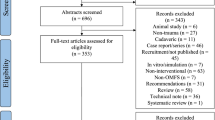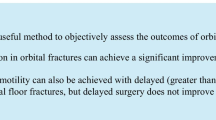Abstract
Background
Orbital hypertelorism (OHT) represents a congenital condition defined by lateralization of the bony orbit, unlike soft tissue telecanthus in which there is an increase in intercanthal distance without true bony lateralization. Existing literature remains very limited in its postoperative assessment of bony versus soft tissue relapse, which may both clinically present as telecanthus. We performed a critical appraisal of the literature to determine the postoperative incidence of bony versus soft tissue relapse following OHT repair.
Methods
The PubMed, MEDLINE, EMBASE, Scopus, Cochrane Central Register of Controlled Trials, and clinicaltrials.org were searched systematically for all English studies published in any time frame reporting relapse rates following primary OHT repair. The primary outcome was incidence of bony and soft tissue relapse defined as orbital lateralization and medial canthal drift, respectively. The secondary outcome measures include postoperative complications, predictors of postoperative complications, timing and type of surgery, and revision rates.
Results
Eleven articles were included. A total of 84 (35.3%) patients experienced bony relapse while 43 (27.2%) patients experienced soft tissue relapse. Age at time of intervention (p < 0.92), severity at presentation (p < 0.90), and surgical technique (p < 0.09) were not found be significantly associated with relapse rate. Methods for long-term follow-up were not standardized, and there was no consistent measure to objectively assess telecanthus.
Conclusions
There is no general consensus on predictive factors of long-term relapse following OHT repair in the form of box osteotomy or facial bipartition. These findings call for cross-sectional outcome standardization to better understand long-term outcomes across institutional, provider, and patient differences.



Similar content being viewed by others
Data availability
The datasets generated during and/or analyzed during the current study are available from the corresponding author on reasonable request.
References
Greig D (1924) Hypertelorism: a hitherto undifferentiated congenital craniofacial deformity. Edinb Med J 31:560
Tessier P (1974) Experiences in the treatment of orbital hypertelorism. Plast Reconstr Surg 53(1):1–18. https://doi.org/10.1097/00006534-197401000-00001LK-
Tan ST, Mulliken JB (1997) Hypertelorism: nosologic analysis of 90 patients. Plast Reconstr Surg 99(2):317–327. https://doi.org/10.1097/00006534-199702000-00004
Patel NP, Tantri MDP (2010) Median cleft of the upper lip: a rare case. Cleft Palate-Craniofacial J 47(6):642–644. https://doi.org/10.1597/09-065LK-
Deshpande G, Campbell A, Jagtap R, Restrepo C (2014) Midline cleft of upper lip: review and surgical repair. J Plast Reconstr Aesthet Surg 67(7):1002–1003. https://doi.org/10.1016/j.bjps.2014.01.032LK-
Pinzer T, Gollogly J, Krishnan KG, Schackert G, Lauer G (2008) Telecanthus and hypertelorism in frontoethmoidal meningoencephaloceles and the surgical correction of these conditions: part I. An orbital anthropomorphometric evaluation of the Khmer subpopulation of Cambodia. J Craniofac Surg 19(1):137–147. https://doi.org/10.1097/scs.0b013e318052fe7aLK
Wu KH, Tsai FJ, Li TC, Tsai CH, Peng CT, Wang TR (2000) Normal values of inner canthal distance, interpupillary distance and palpebral fissure length in normal Chinese children in Taiwan. Acta Paediatr Taiwan 41(1):22–27
David DJ (1993) Cephaloceles: classification, pathology, and management--a review. J Craniofac Surg 4(4):192–202
Shakir S, Hoppe IC, Taylor JA (2019) State-of-the-art hypertelorism management. Clin Plast Surg 46(2):185–195. https://doi.org/10.1016/j.cps.2018.11.004
Tessier P, Guiot G, Derome P (1973) Orbital hypertelorism. II. Definite treatment of orbital hypertelorism (OR.H.) by craniofacial or by extracranial osteotomies. Scand J Plast Reconstr Surg 7(1):39–58. https://doi.org/10.3109/02844317309072417
Tessier P (1972) Orbital hypertelorism. I. Successive surgical attempts. Material and methods. Causes and mechanisms. Scand J Plast Reconstr Surg 6(2):135–155. https://doi.org/10.3109/02844317209036714
Marchac D, Arnaud E (1999) Midface surgery from Tessier to distraction. Childs Nerv Syst 15(11-12):681–694. https://doi.org/10.1007/s003810050458LK-
van der Meulen JC (1979) Medial fasciotomy. Br J Plast Surg 32(4):339–342. https://doi.org/10.1016/0007-1226(79)90095-XLK-
Boonvisut S, Ladpli S, Sujatanond M, Tisavipat N, Luxsuwong M, Nunta-aree S, Boonampol D, Dulayajinda D, Areewattana S, Srimaharaja S, Panitphong T (2001) A new technique for the repair and reconstruction of frontoethmoidal encephalomeningoceles by medial orbital composite-unit translocation. Br J Plast Surg 54(2):93–101. https://doi.org/10.1054/bjps.2000.3487LK-
Moher D, Liberati A, Tetzlaff J, Altman DG (2010) Preferred reporting items for systematic reviews and meta-analyses: the PRISMA statement. Int J Surg 8(5):336–341. https://doi.org/10.1016/j.ijsu.2010.02.007
Slim K, Nini E, Forestier D, Kwiatkowski F, Panis Y, Chipponi J (2003) Methodological index for non-randomized studies (MINORS): development and validation of a new instrument. ANZ J Surg 73(9):712–716. https://doi.org/10.1046/j.1445-2197.2003.02748.x
Breakey W, Abela C, Evans R, Jeelani O, Britto J, Hayward R, Dunaway D (2015) Hypertelorism correction with facial bipartition and box osteotomy: does soft tissue translation correlate with bony movement? J Craniofac Surg 26(1):196–200. https://doi.org/10.1097/SCS.0000000000001237LK-
Glass GE, Hon KAV, Schweibert K, Bowman R, Jones BM, Dunaway DJ, Britto JA (2017) Ocular morbidity in the correction of orbital hypertelorism and dystopia: a 15-year experience. Plast Reconstr Surg 139(4):967–975. https://doi.org/10.1097/PRS.0000000000003178
Jiang T, Yu Z, Chi T-Y, Kang BK, Gao J, Wei M, Yuan J, Xu L, Duan H, Mu X, Cao D (2020) Postoperative complications of box-shift osteotomy for orbital hypertelorism. J Craniofac Surg 31(2):385–388. https://doi.org/10.1097/SCS.0000000000006051LK-
Marchac D, Sati S, Renier D, Deschamps-Braly J, Marchac A (2012) Hypertelorism correction: what happens with growth? Evaluation of a series of 95 surgical cases. Plast Reconstr Surg 129:713–727. https://doi.org/10.1097/PRS.0b013e3182402db1
McCarthy JG, LaTrenta GS, Breitbart AS, Zide BM, Cutting CB (1990) Hypertelorism correction in the young child. Plast Reconstr Surg 86(2):226–228
Medra AM, Hassanein AG, Fadle KN (2019) Controversy on the age of hypertelorism correction. J Craniofac Surg 30(6):1859–1865. https://doi.org/10.1097/SCS.0000000000005625
Monasterio FO, Molina F, Sigler A, Dahan P, Alvarez L (1996) Maxillary growth in children after early facial bipartition. J Craniofac Surg 7(6):440–448. https://doi.org/10.1097/00001665-199611000-00010
Mulliken JB, Kaban LB, Evans CA, Strand RD, Murray JE (1986) Facial skeletal changes following hypertelorbitism correction. Plast Reconstr Surg 77(1):7–16
Raposo-Amaral CE, Raposo-Amaral CM, Raposo-Amaral CA, Chahal H, Bradley JP, Jarrahy R (2011) Age at surgery significantly impacts the amount of orbital relapse following hypertelorbitism correction: a 30-year longitudinal study. Plast Reconstr Surg 127(4):1620–1630. https://doi.org/10.1097/PRS.0b013e31820a6472
Raposo-Amaral CE, Denadai R, Ghizoni E, Raposo-Amaral CA (2017) Surgical strategies for soft tissue management in hypertelorbitism. Ann Plast Surg 78(4):421–427. https://doi.org/10.1097/SAP.0000000000000915LK-
Yang X, Mu X, Gu Q et al (2009) Oriental surgical protocol in orbital hypertelorism. J Craniofac Surg 20:718–723. https://doi.org/10.1097/SCS.0b013e3181a2de32LK-
Whitaker LA, Bartlett SP, Schut L, Bruce D (1987) Craniosynostosis: an analysis of the timing, treatment, and complications in 164 consecutive patients. Plast Reconstr Surg 80(2):195–212
Fearon J, Bartlett S, Whitaker L (1991) The skeletal treatment of orbital hypertelorism. Neurosurg Clin N Am 2:673–681
Cohen MM Jr, Richieri-Costa A, Guion-Almeida ML, Saavedra D (1995) Hypertelorism: interorbital growth, measurements, and pathogenetic considerations. Int J Oral Maxillofac Surg 24(6):387–395. https://doi.org/10.1016/S0901-5027(05)80465-5
Costaras M, Pruzansky S, Broadbent BH (1982) Bony interorbital distance (BIOD), head size, and level of the cribriform plate relative to orbital height: I. Normal standards for age and sex. J Craniofac Genet Dev Biol 2(1):5–18
Costaras M, Pruzansky S (1982) Bony interorbital distance (BIOD), head size, and level of the cribriform plate relative to orbital height: II. Possible pathogenesis of orbital hypertelorism. J Craniofac Genet Dev Biol 2(1):19–34
Mccarthy J, Coccaro P, Wood-Smith D, Converse J (1979) Longitudinal cephalometric studies following surgical correction of orbital hypertelorism: a preliminary report. In: Symposium on Diagnosis and Treatment of Craniofacial Anomalies. St. Louis:229
Tahiri Y, Taylor JA (2015) In support of using computer-aided design and modeling for periorbital osteotomies. J Craniofac Surg 26(1):100–103
Schlund M, Paré A, Joly A, Laure B (2018) Computer-assisted surgery in facial bipartition surgery. J Oral Maxillofac Surg 76:1094
Adolphs N, Haberl E-J, Liu W, Keeve E, Menneking H, Hoffmeister B (2014) Virtual planning for craniomaxillofacial surgery—7 years of experience. J Craniomaxillofac Surg 42:e289–e295
Batut C, Paré A, Kulker D et al (2020) How accurate is computer-assisted orbital hypertelorism surgery? Comparison of the three-dimensional surgical planning with postoperative outcomes. Facial Plast Surg Aesthet Med 22(6)
Funding
The authors acknowledge no funding or grants in the conception of this research paper.
Author information
Authors and Affiliations
Contributions
All authors contributed to the study conception and design. Material preparation, data collection, and analysis were performed by Beatrice Go, Sameer Shakir, Jordan Swanson, Scott Bartlett, and Jesse Taylor. The first draft of the manuscript was written by Beatrice Go and Sameer Shakir and all authors commented on previous versions of the manuscript. Jordan Swanson, Scott Bartlett, and Jesse Taylor critically revised the work. All authors read and approved the final manuscript.
Corresponding author
Ethics declarations
Conflicts of interest
On behalf of all authors, the corresponding author states that there is no conflict of interest.
Ethics approval
N/A
Consent to participate
N/A
Consent for publication
N/A
Code availability
N/A
Additional information
Publisher’s note
Springer Nature remains neutral with regard to jurisdictional claims in published maps and institutional affiliations.
Electronic supplementary material
ESM 1
(DOCX 16 kb)
Rights and permissions
About this article
Cite this article
Go, B.C., Shakir, S., Swanson, J.W. et al. A critical appraisal of surgical outcomes following orbital hypertelorism correction: what is the incidence of true bony relapse versus soft tissue telecanthus?. Childs Nerv Syst 37, 21–32 (2021). https://doi.org/10.1007/s00381-020-04890-2
Received:
Accepted:
Published:
Issue Date:
DOI: https://doi.org/10.1007/s00381-020-04890-2




